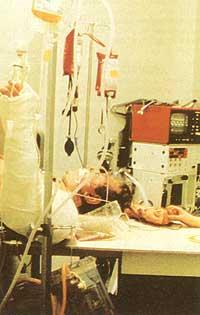Ill Public Health
1994/04/01 Alvarez, Mikel Iturria: Elhuyar aldizkaria
Societies XX. One of the greatest advances achieved in the twentieth century is the development of Medicine. As in many other fields, the same advance of technology has combined the evolution of this science. II. After the World War, the Chamber of Knowledge of Medicine has grown a lot, for example, if a medical specialist dedicated eight hours a day to reading the articles published in his specialty and did so for a year, he could only read 20% of what is published in this specialty.
But XX. The twentieth century, in addition to offering great technological advances, has undoubtedly represented another treasure for the area of Health, Public Health within reach of all. Most of the health services of yesteryear were institutions under the tutelage of the Church. And, of course, the Church could hardly sustain the expense of these new, technified health services. Therefore, as the Church began to withdraw from hospitals and other health services, the vacuum remained in the hands of civil society, of political society. And there it began, say, the current history.

The evolutions of the Public Health Service in countries around the world have been danced according to the budgets or subsidies of the States. In Spain (and necessarily in Hego Euskal Herria) in the 50s and 60s several health residences or large hospitals were opened. The economy, at that time, also had great growth and had to have a reflection on public expenditure. Hospitals opened in those decades were slowly filled with beds following the law of supply and in the 1980s they were filled with beds, rooms and corridors or corridors that did not know where to get in. The Cruces Hospital, for example, counted at the beginning of the 1980s with 1,600-1,700 beds.
And at this point, when the currency could not be connected and public resources were fleeing from the river to the sea, just like the waters dragged by the flood, someone wondered if that Health Structure was necessary and if it was possible to obtain other Structures without so much economic loss. However, the question did not find adequate ground for its development and the budgets of the time were not so small. And in the 1990s? Due to the global economic crisis, public services have also suffered cuts and that disproportionate and misleading growth in health has led to an accurate exploration of resources.
I see four jobs that must be worked on this goal of streamlining resources. 1. The first, a reflection on technological and therapeutic advances, considering that it is not possible to have any sanitary provision without criteria, without filtering. 2. Need for hospital emptying with reduction of the average stay. Use home hospitalisation systems, as they are more suitable for the patient and are also cheaper. 3. Change the forms of internal management of Public Health, strengthening functional structures. Finally, I would say that we form what we form, that everything has to dance around an axis, that is, that we must promote information systems that are built around the patient and for the sake of correction.
Therefore, if we want Public Health Services to remain, we will save resources and be health conservatives.

Gai honi buruzko eduki gehiago
Elhuyarrek garatutako teknologia






